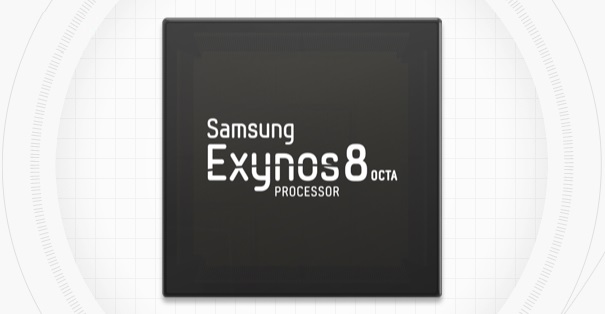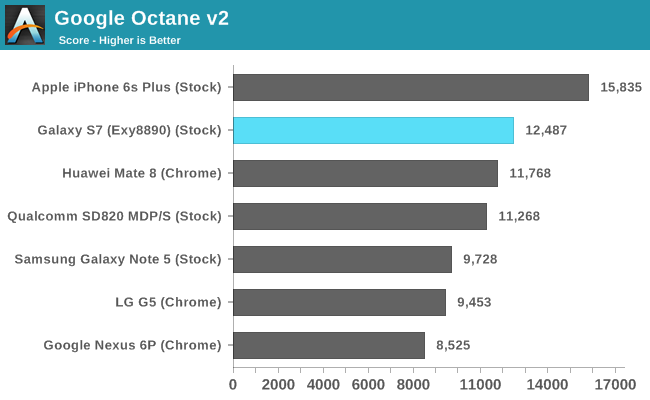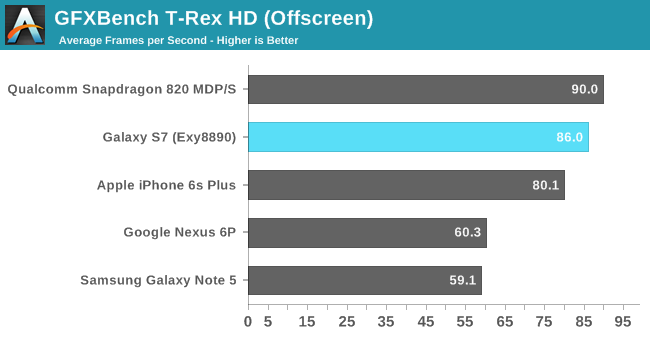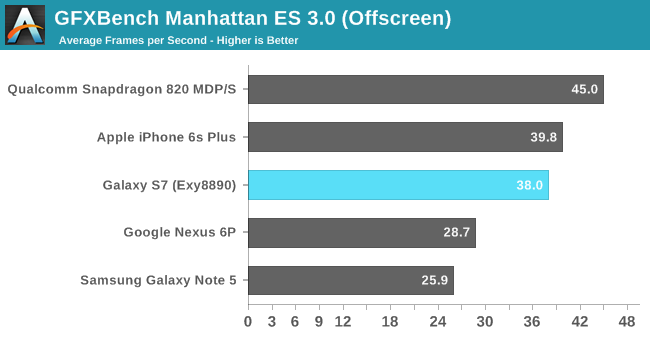Early Exynos 8890 Impressions And Full Specifications
by Andrei Frumusanu on February 21, 2016 6:15 PM EST- Posted in
- Smartphones
- Mobile
- SoCs
- Exynos 8890
- Exynos M1
- Samsung Galaxy S7

| High-End SoCs Specifications | |||
| SoC | Snapdragon 820 | Exynos 8890 | Exynos 7420 |
| CPU | 2x Kryo@1.593GHz 2x Kryo@2.150GHz |
4x A53@1.586GHz 4x Exynos M1 @ 2.60GHz (1-2 core load) 2.29GHz (3-4 core load) |
4x A53@1.50GHz 4x A57@2.1GHz |
| Memory Controller |
2x 32-bit LPDDR4 @ 1803MHz 28.8GB/s b/w |
2x 32-bit LPDDR4 @ 1794MHz 28.7GB/s b/w |
2x 32-bit LPDDR4 @ 1555MHz 24.8GB/s b/w |
| GPU | Adreno 530 @ 624MHz |
Mali T880MP12 @ 650MHz |
Mali T770MP8 @ 770MHz |
| Mfc. Process |
Samsung 14nm LPP |
Samsung 14nm LPP |
Samsung 14nm LPE |
The Exynos 8890 employs Samsung's own designed Exynos M1 cores. The micro-architecture at a high level resembles ARM's big cores, but Samsung seems to have made quite a few changes and improvements when compared to ARM's designs. While by now I do have a quite good idea of what the Exynos M1 looks like, we'll be covering the topic more in-depth in a future article once we'll be able to gain better insight from our own unit for proper benchmarking and power measurements.
On the CPU side we find an 8-core SoC composed of 4x Cortex A53 cores running at up to 1.586GHz coupled with 4x Exynos M1 cores in a big.LITTLE configuration. The most surprising revelation was the fact that the M1 cores reach an extremely high clock of up to 2.6GHz. This represents quite a significant boost over some past rumors which had put expectations 2.3-2.4GHz maximum frequency range. The catch here is that the Galaxy S7's power management doesn't allow all four cores to run at this high frequency but rather only enables the maximum clock when there's at most 2 cores loaded. If there are 3 or more cores under high load, the CPU frequency doesn't surpass 2288MHz.
On the GPU side we knew that we'd encounter a new ARM Mali T880MP12 - the currently largest Mali implementation available among existing SoCs. Back in November I theorized that Samsung would use the larger core implementation to lower the clocks of the GPU block and thus achieve better power efficiency. Indeed that's what seems to have happened as the Exynos 8890's GPU peaks at 650MHz versus the 770MHz frequency for the Exynos 7420. Hopefully this means that the new SoC will be able to maintain its peak performance for longer periods of time.


While I didn't have the time to run too many benchmarks, I did manage to run a few of our basic browser tests as well as GFXBench. We haven't had the opportunity to benchmark the Snapdragon 820 Galaxy S7 yet, therefore I included the score numbers of the MDP/S platform to represent a best-case scenario for the Snapdragon 820 until we can get apples-to-apples scores based on Samsung's browser. This still mostly due to the fact that Chrome is seemingly not yet optimized to take advantage of Kryo's new architecture, and as a result scores some rather mediocre numbers, as seen in some preliminary LG G5 numbers included in the graphs above.


Some quick GPU benchmarks also put the Exynos 8890 slightly behind the Snapdragon 820 in the MDP/S. We will still have to see if actual Snapdragon 820 devices are able to deliver the same performance as the MDP/S platform as there might be some thermal limitations coming into play. Again, we can't comment too much on the scores before we get to know each device's long-term performance and if the attained numbers are sustainable for long periods of time.
One observation I made today which was particularly concerning, was that both with the Snapdragon 820 LG G5 as well as the Exynos 8890 Galaxy S7 got considerably warm after running some heavy workloads. The fact that the Galaxy S7 touts having a heat-pipe thermal dissipation system is a quite worrying characteristic of the phone and should in no way be seen as a positive feature as it points to high power draw figures on the part of the SoC.
The first impression is that the performance difference between the Snapdragon 820 and the Exynos 8890 doesn't seem to be very large, therefore it will be the SoC's power draws and power efficiencies which will determine if, and which one of both will represent a superior design. Hopefully in the coming weeks and months we'll be able to get a better understanding of this new generation of SoCs so that we can paint a definitive picture of the current status of the mobile SoC space.










94 Comments
View All Comments
milli - Monday, February 22, 2016 - link
That doesn't prove that Chrome for ARM is unoptimized.Intel processors have excellent cache and memory subsystems, fantastic branch misprediction and are deeply OoO. They are much better at these things than general ARM processors.
These are also things that you can't measure with useless benchmarks like Geekbench because these can fully reside in the L1 cache.
Exophase - Thursday, February 25, 2016 - link
We're talking about Silvermont here, not Skylake. It hardly has notably superior cache, memory subsystems or branch prediction compared to the Cortex-A57 in Note 5 and it's much less deeply OoO.Geekbench is also very far from fully residing in L1 cache, it's not Dhrystone.
lilmoe - Sunday, February 21, 2016 - link
JS benchmarks are BROWSER BENCHMARKS, NOT CPU benchmarks. Get that through to your head already.Show me a video where an iPhone 6S "significantly" beats a GS6 in REAL WORLD loading of webpages. Sheeshh....
ciderrules - Monday, February 22, 2016 - link
Oh look, a logical fallacy. Shift the burden of proof to others and ask them to provide the evidence to counter your claims instead of proving them yourself.ciderrules - Monday, February 22, 2016 - link
A logical fallacy I see. Shift the burden of proof to others instead of providing the proof yourself.lilmoe - Monday, February 22, 2016 - link
Youtube is filled with these comparison videos, smarty pants. Take your pick.easp - Monday, February 22, 2016 - link
An your point is what, that you buy phones to run CPU benchmarks?ciderrules - Monday, February 22, 2016 - link
Complete rubbish.The A9 absolutely TROUNCES the 7420 in single core performance and they are essentially equal in multi core.
"Let the single-threaded argument go, people".
Spoken like someone on the losing end of single core performance who's desperately trying to justify having multiple cores when most of the software they use can't even take advantage of them.
lilmoe - Monday, February 22, 2016 - link
None of you are interested in an educated discussion, and I'm certainly not interested in a flame war."most of the software they use can't even take advantage of them"
See what what I mean? Do your research before whining.
ciderrules - Monday, February 22, 2016 - link
Sorry, but I write code. It is very difficult (outside of benchmarks or certain special use cases) to divide your code into threads and have each of those threads doing an equal amount of work. A thread running on a separate core that's sitting idle much of the time (say a thread monitoring the touchscreen for input) isn't properly utilizing that core at all.